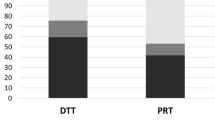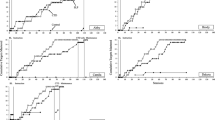Abstract
This study compared conditions of brief and extended wait time on opportunities to respond, rate of responding, rate of correct responding, and disruptive behavior of two students with autism spectrum disorder during one-on-one teaching. Brief wait time increased students’ opportunities to respond per minute, responses per minute, and correct responses per minute. While variable, slightly fewer instances of problem behavior were also produced by the brief wait time condition. The current study supports previous findings that suggested use of brief wait time during instruction for children with learning and behavioral challenges. It does not support opposing results of previous research which favored longer wait times for teaching children with intellectual and developmental disabilities. Limitations and implications for future research are discussed.



Similar content being viewed by others
References
Berrong, A. K., Schuster, J. W., Morse, T. E., & Collins, B. C. (2007). The effects of response cards on active participation and social behavior of students with moderate and severe disabilities. Journal of Developmental & Physical Disabilities, 19, 187–199.
Burns, M. K. (2007). Comparison of opportunities to respond within a drill model when rehearsing sight words with a child with mental retardation. School Psychology Quarterly, 22, 250–263.
Carine, D. W. (1976). Effects of two teacher presentation rates on off-task behavior, answering correctly, and participation. Journal of Applied Behavior Analysis, 9, 199–206.
Christle, C. A., & Schuster, J. W. (2003). The effects of using response cards on student participation, academic achievement, and on-task behavior during whole-class math instruction. Journal of Behavioral Education, 12, 147–165.
Cooper, J. O., Heron, T. E., & Heward, W. L. (2007). Applied behavior analysis (2nd ed.). Upper Saddle River: Pearson.
Duker, P. C., Van Doeselaar, C., & Vestraten, A. (1993). The effect of response delay on correct responding to instructions during communicative gesture training. Education & Training in Mental Retardation, 28, 327–332.
Dunlap, G., Dyer, K., & Koegel, R. L. (1983). Autistic self-stimulation and intertrial interval duration. American Journal of Mental Deficiency, 88, 194–202.
Dyer, K., Christian, W. P., & Luce, S. C. (1982). The role of response delay in improving the discrimination performance of autistic children. Journal of Applied Behavior Analysis, 15, 231–240.
Gardner, R., Heward, W. L., & Grossi, T. A. (1994). Effects of response cards on student participation and academic achievement: a systematic replication with inner-city students during whole-class science instruction. Journal of Applied Behavior Analysis, 27, 63–71.
Gilbertson, D., & Bluck, J. (2006). Improving responsiveness to intervention for English-Language Learners: a comparison of instructional pace on letter naming rates. Journal of Behavioral Education, 15, 131–147.
Haydon, T., Mancil, G. R., & Van Loan, C. (2009). Using opportunities to respond in a general education classroom: a case study. Education and Treatment of Children, 32, 267–278.
Heward, W. L. (1994). Three “low tech” strategies for increasing the frequency of active child response during group instruction. In R. Gardiner III, D. M. Sainato, J. O. Cooper, T. E. Heron, W. L. Heward, J. Eshleman, & T. A. Grossi (Eds.), Behavior analysis in education: Focus on measurable superior instruction (pp. 283–320). Pacific Grove: Brooks/Cole.
Koegel, R. L., Dunlap, G., & Dyer, K. (1980). Intertrial interval duration and learning in autistic children. Journal of Applied Behavior Analysis, 13, 91–99.
Partin, M., Robertson, R., Maggin, D., Oliver, R., & Wehby, J. (2010). Using teacher praise and opportunities to respond to promote appropriate student behavior. Preventing School Failure, 54, 172–178.
Sutherland, K. S., Alder, N., & Gunter, P. L. (2003). The effect of varying rates of OTR on the classroom behavior of students with EBD. Journal of Emotional and Behavioral Disorders, 11, 239–248.
Szadokierski, I., & Burns, M. K. (2008). Analogue evaluation of the effects o opportunities to respond and ratios of known items within drill rehearsal of Esperanto words. Journal of School Psychology, 46, 593–609.
Tincani, M., & Crozier, S. (2008). Comparing brief and extended wait time during small group instruction for children with challenging behavior. Journal of Behavioral Education, 17, 79–92.
Tincani, M., Ernsbarger, S., Harrison, T. J., & Heward, W. L. (2005). Effects of two instructional paces on pre-K children’s participation rate, accuracy, and off-task behavior in the Language for Learning Program. Journal of Direct Instruction, 5, 97–109.
Valcante, G., Roberson, W., Reid, W. R., & Wolking, W. D. (1989). Effects of wait-time and intertrial interval durations on learning by children with multiple handicaps. Journal of Applied Behavior Analysis, 22, 43–55.
West, R., & Sloane, H. (1986). Teacher presentation rate and point delivery rate: effect on classroom disruption, performance accuracy, and response rate. Behavior Modification, 10, 267–286.
Wood, C., Marby, L., Kretlow, A., Lo, Y., & Galloway, T. (2009). Effects of preprinted response cards on students’ participation and off-task behavior in a rural kindergarten classroom. Rural Special Education Quarterly, 28, 39–47.
Author information
Authors and Affiliations
Corresponding author
Rights and permissions
About this article
Cite this article
Lamella, L., Tincani, M. Brief Wait Time to Increase Response Opportunity and Correct Responding of Children with Autism Spectrum Disorder Who Display Challenging Behavior. J Dev Phys Disabil 24, 559–573 (2012). https://doi.org/10.1007/s10882-012-9289-x
Published:
Issue Date:
DOI: https://doi.org/10.1007/s10882-012-9289-x




